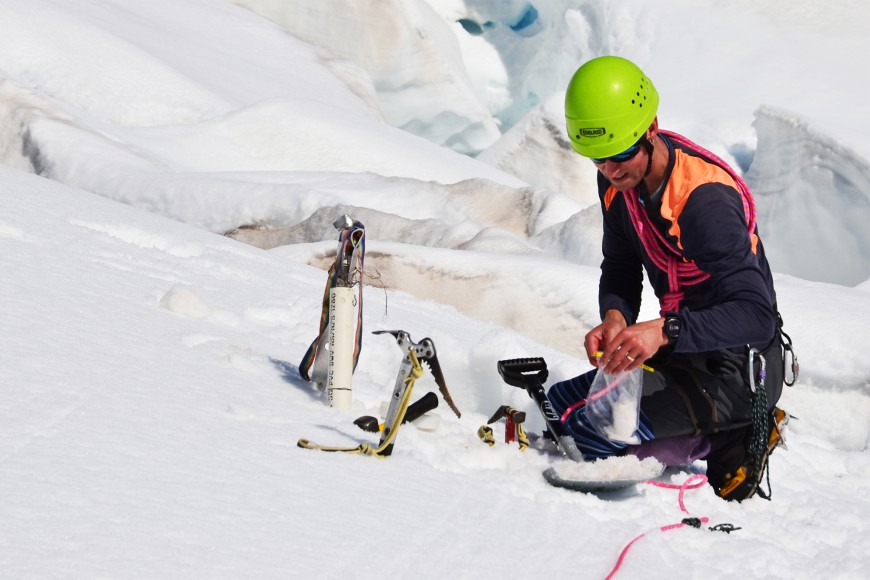With New Zealand’s glaciers already in steep decline owing to climate change, the coating of bushfire ash attracted concern from scientists, members of the public, and even from former prime minister Helen Clark, worried that the dark dust would absorb the sun’s heat and accelerate icemelt.
Manaaki Whenua’s Dr Phil Novis, an algae expert whose interest in ice stems from the microbial communities naturally present there, is now working with Drs John Hunt and Ben Jolly, also of Manaaki Whenua, Drs Lynda Petherick and Ruzica Dadic from Victoria University, and Dr Heather Purdie from the University of Canterbury to investigate the interactions between snow algae and the bushfire aerosols, and their impacts on melting.

Phil Novis taking snow and ice samples from the Franz Josef Glacier in Westland Tai Poutini National Park. Image: John Hunt.
Fundamentally, the project is about albedo: a measure of the amount of solar radiation that is reflected back from the Earth’s surface. The albedo of pure snow is high, with a large proportion of the incoming radiation reflected back, keeping things cool. However, explains Dr Novis, it takes surprisingly little to lower the albedo of snow.
“One substance that reduces the albedo of snow very efficiently is black carbon, which is formed by incomplete combustion of biomass, as happened with the Australian bushfires. A huge quantity of material including black carbon was carried across the Tasman – we estimated that around 80 tonnes of black carbon, other organic matter and dust fell on the Fox Glacier alone. Earlier research has shown that black carbon present in fresh snow at concentrations undiscernible by the human eye could substantially reduce its albedo. Given how discoloured glaciers became during the bushfires, we expect a large – but currently unquantified – impact.”
Adding to the problem are microbial communities including snow algae, which visibly add colour to snow (typically red, pink, or orange) when they bloom. These communities also reduce the albedo of snow and cause positive feedback loops: they need liquid water in the snow to grow, and their growth promotes liquid water by increasing albedo and melting, and so the cycle continues.
According to Dr Novis, we don’t yet know how these types of particles interact. “Bushfire ash is a fertiliser, but adding it to an ecosystem can raise the pH, something to which snow algae are known to be sensitive. Do aerosols in snow from the bushfires promote algal growth, or hinder it? The answer could have large implications for the effect of these events on our glacial systems.
To help answer these questions, field plots will receive randomly assigned standardised application of bushfire material to snow, with the effect on albedo measured using radiometers above the plot and on a nearby temporary weather station. Other changes to snow physics and chemistry will also be determined. The main site for the field experiments will be the snow accumulation zone at the head of the Tasman Glacier.
“Possible impacts of the Australian bushfires on New Zealand glaciers, and the primary producers that colonise them, are even more concerning, given recent findings that these glaciers may be a global diversity hotspot for cryophilic invertebrates. These species ultimately rely on snow and ice algae at the bottom of their food chain.”
“My hope with these interdisciplinary projects is always that they are greater than the sum of their parts – by working with people of different backgrounds and skills we can address questions that might otherwise go unanswered – and maybe even think of questions that no one has thought to ask! In this case, it’s the interaction between snow microbiology, physics and chemistry in the context of climate change and the predicted increase in frequency of bushfires in Australia affecting glacial systems here.”

